California is in the midst of a whopper of a fish tale -- yet it’s all entirely true.
With riverways dry and a billion-dollar industry on the line, workers in Northern California are engaged in a massive, spring-long mission to vacuum 25.5 million baby salmon from five inland hatcheries and haul them, in trucks, to the coast.
They’re pumping the smolts into oxygenated vats then giving each fish a lengthy, one-way ride to the Pacific. They’re using highways to navigate past almond orchards, scrubland and golf courses, all to get the fish past the drought-stricken waterways that are the king salmon’s usual route to the ocean.
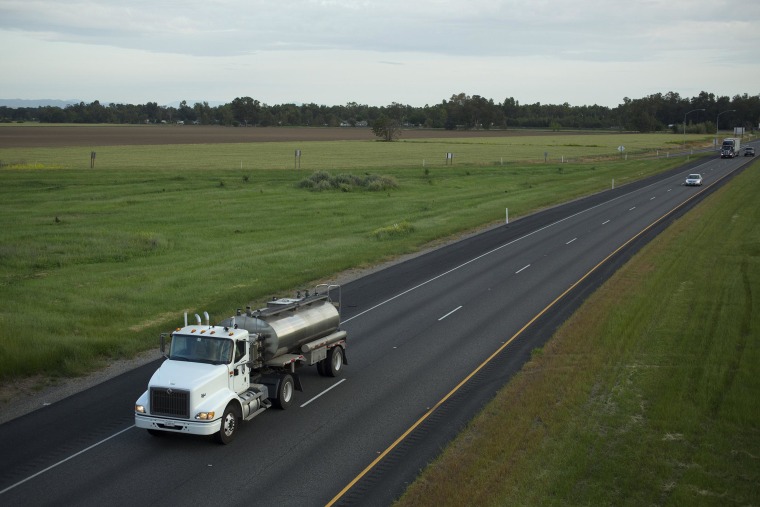
To get the job done, wildlife workers have adopted their own version of Noah’s Ark: climate-controlled tanker trucks that carry about 130,000 fish apiece.
“This is a Herculean effort,” said Andrew Hughan, spokesman for the California Department of Fish and Wildlife. That agency is mounting the salvage operation in tandem with federal officials.
“If we didn’t do this,” Hughan said, “there wouldn’t be any fish and there wouldn’t be any fishing industry.”
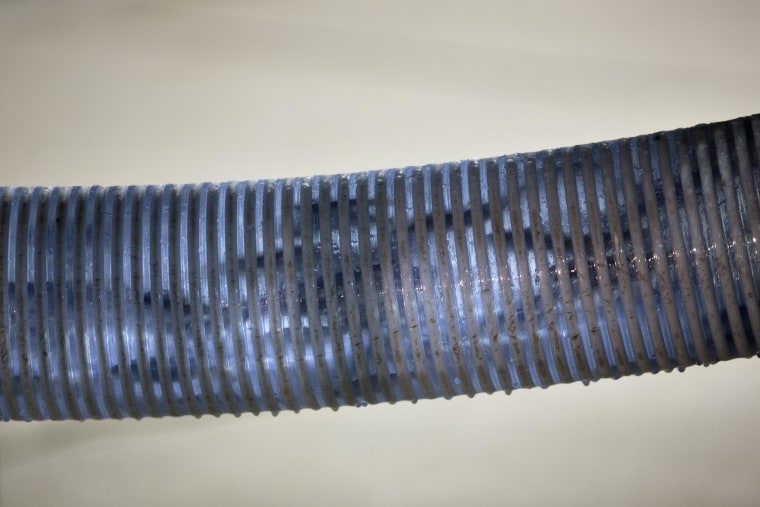
By trucking a record number of fish now through early June, state and federal wildlife workers aim to prevent a collapse of the king salmon season in 2016. That year, these smolts will be large enough to catch and old enough to swim upstream to their hatcheries to spawn and repopulate before dying.
“This is a Herculean effort .... If we didn’t do this, there wouldn’t be any fish and there wouldn’t be any fishing industry.”
The ongoing drought in California, which according to some scientists may be the state’s worst on record, has turned rivers into potential death traps for baby salmon, making flows too shallow and water temperatures too warm while also exposing the fish to more predators, experts say.
And for some 12 million smolts from the Coleman National Fish Hatchery, a federally run incubator near Redding, Calif., their usual 275-mile journey to the coast also contains a man-made threat.
Below Sacramento, the Delta Cross Channel Gates may temporarily open in early May, federal officials have said. During heavy drought, those gates are opened along the Sacramento River to increase fresh water supplies. When that occurs, however, migrating salmon are known to make a fatal wrong turn -– to an inland delta instead of toward the ocean.
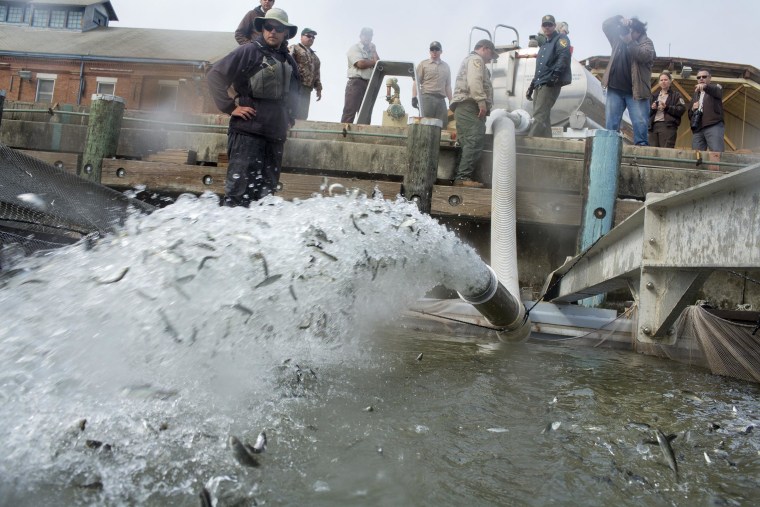
“They’re wandering into a labyrinth,” said Bob Clarke, fisheries program supervisor at the U.S. Fish and Wildlife Service. “We know from doing studies, they just get lost and don’t make it out in great numbers.”
The mere prospect of soon-open gates was one “trigger” that prompted workers to truck nearly 4 million baby salmon this week alone from the Coleman hatchery to San Pablo Bay, where they were released into net pens. After acclimating for a few hours, they were freed to head under the Golden Gate Bridge and out to the Pacific.
If all this high-tech hitchhiking to save some fish seems like too much work and too much expense –- (reported cost estimates range as high as $800,000) –- California merchants assert the plan will save more than 23,000 jobs tied directly to the salmon industry, from tackle shops to commercial boats to coastal hotels.
Meanwhile, salmon diners as far away as Manhattan also may argue that the mammoth operation out West will eventually fill their bellies with one of their favorite meals: typically served grilled, baked, smoked, or as lox.
“King salmon is, well, the king, the bomb, the stuff you want, and the best restaurant dishes,” said John McManus, executive director of the Golden Gate Salmon Association, which advocates for professional anglers, eateries, and shops. Commercially caught king salmon are sent to market starting in May, getting hauled once again -– this time, across the country and on ice.
Choppy waters off California -– where those fish spend the bulk of their short lives -– offer an ideal soup to infuse king salmon with their singular flavor.
“King salmon is, well, the king, the bomb, the stuff you want, and the best restaurant dishes."
Heavy northwest winds churn microscopic plant nutrients from the ocean floor, elevating them to the surface where they bloom in sunshine, becoming food for tiny, shrimp-like crustaceans called krill.
“Salmon gobble the krill by the zillions, and, I’m telling you, eating salmon that have been feeding on krill is as good as it gets,” McManus said. (King salmon, also called Chinook, can grow to weigh 50 pounds or more).
The famously pink meat from those wild fish drives a $1.4 billion annual industry for California, McManus said. (During non-drought years, state wildlife workers routinely truck 15 million baby salmon to help their fishing seasons flourish).
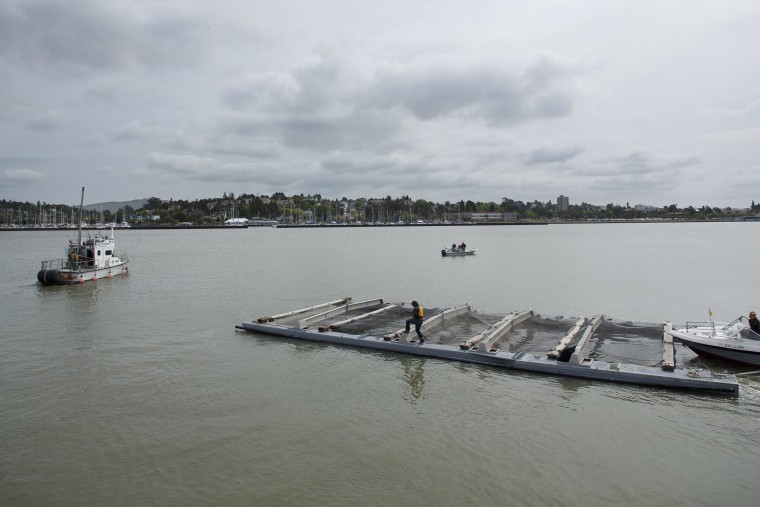
Fifty-six feet of the billion-dollar industry rest on the deck of “The Salty Lady,” a charter boat for amateur salmon hunters. When not trolling the Pacific, she’s berthed in Sausalito's Clipper Yacht Harbor.
"This year, because we saw the drought coming, we put on an all-out effort politically to get this trucking done” from the Coleman hatchery, said Roger Thomas, skipper of “The Salty Lady.” “Otherwise, the feds never would have trucked.”
“They’re popular to catch because they’re some of the best food you can eat –- healthy, beautiful, oily. And they also fight good at the end of the line."
In both 2008 and 2009, after returning salmon dwindled to dangerously low numbers, wildlife officials cancelled California's salmon-fishing seasons, devastating small-business owners like Thomas and coastal fishing villages. The fish population’s temporary collapse was blamed, in part, on the delta gates being open to increase fresh-water supplies.
“That was an outright disaster,” said Thomas, who grudgingly accepted “disaster funding” and offered whale-watching trips. No salmon were trucked from the federal Coleman hatchery those years.
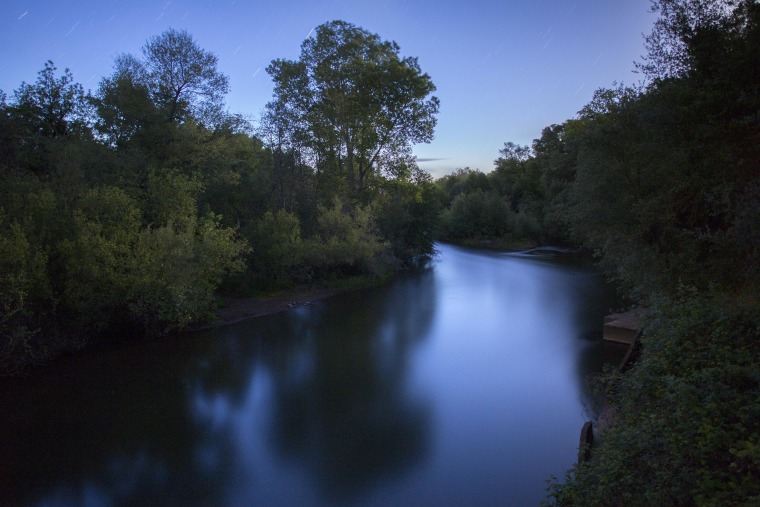
“Salmon fishing is the heart of our (charter) industry and the commercial fisheries,” Thomas said. “They’re popular to catch because they’re some of the best food you can eat –- healthy, beautiful, oily. And they also fight good at the end of the line.
“We fought to save our 2016 season –- many meetings, many discussions with federal and state entities, congressmen and U.S. senators, convincing them to get this job done. We worked hard to protect these salmon.”